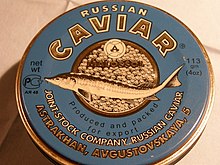Malossol
Malossol is the Russian word for 'lightly / slightly salted' ( salt content : 2.8 - 4%). It usually says on caviar cans. This word is made up of the terms malo for little and sol for salt, but does not name the sturgeon from whose roe the caviar comes. "Beluga Malossol", "Sevruga Malossol", "Ossietra Malossol" are some of the correct names.
Salt
Salting makes caviar more durable . The salt content determines the quality and always depends on the season. Since the cold in the winter months contributes significantly to the shelf life, the caviar is less salted. High quality caviar is salted just as much as is necessary for a limited shelf life. That is why caviar is considered to be the best variety in winter, as it does not affect its own taste as much.
Lightly salted caviar is called "Malossol caviar". The counterpart to the Malossol is the so-called press or napkin caviar.
Freshly caught, untreated sturgeon roe is light and glassy and only turns dark when it is treated with salt. Very weakly salted (high quality) caviar is therefore rarely deep black.
